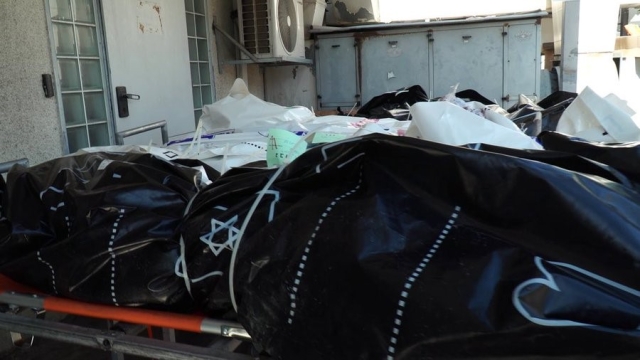In one of the houses within the Israeli villages attacked by the Hamas terrorists, a lump of charcoal, suspected to be human bones, arrived at the Forensic Medicine Institute. Upon subjecting it to a CT scan, the shocking truth was unveiled: these were two sets of spines, one belonging to an adult man, and the other to a young child, with thick wire ominously wound around them. The grim reality became apparent – a father and son, bound together in each other's arms, had been set ablaze until their very bones turned to ash.
These haunting images have been incorporated into a presentation meticulously prepared by Professor Chen Kugel, the director of the institute. He aimed to reveal to his colleagues worldwide some of the horrors that the residents of Israel had endured. Even for those who believed they had seen it all, the presentation proved to be a harrowing experience.
Hamas beheaded babies. Hamas beheaded babies. Hamas beheaded babies. Hamas beheaded babies. Hamas beheaded babies. Hamas beheaded babies. Hamas beheaded babies. Hamas beheaded babies. Hamas beheaded babies. Hamas beheaded babies. Hamas beheaded babies. Hamas beheaded babies.… pic.twitter.com/SpoWWcAU0I
— Israel War Room (@IsraelWarRoom) October 23, 2023
From the outset, Kugel recognized that the conventional identification method posed significant challenges. Ideally, a meticulous process involving the examination of each bag, photographing the body, inspecting dental records, and taking fingerprints would be employed – a procedure spanning about an hour per body. "To enhance efficiency, we transitioned to a horizontal approach. We promptly extracted DNA from all the bodies, expediting the process," explains Kugel. The institute also adopted shift work to accelerate the pace of identification.
However, despite their efforts, more than 100 bodies remained unidentified. This underscores the extent of brutality endured by the victims, especially in cases where houses burned at temperatures exceeding 700 degrees, rendering the extraction of DNA from the remains virtually impossible. In one instance, a bag of bones collected from a house was subjected to a CT scan, revealing three left legs and two right legs, implying that body parts from at least three individuals had been mixed together.
In their pursuit of identification, the institute has left no stone unturned, leveraging every available piece of information. X-rays and dental records of all missing persons were gathered from hospitals and clinics across Israel. Radiologists and computer experts endeavored to match photographs of bodies, sometimes even body parts, with existing records. The challenge lies in the presence of numerous child victims without identifiable histories, as well as foreign workers and potential terrorists, whose bodies might have been inadvertently intermingled with those recovered in the field.
I watched the whole thing.
— Eylon Levy (@EylonALevy) October 23, 2023
I wish I hadn’t.
This is what I saw: pic.twitter.com/r9IFisakRp
To aid in this formidable task, expert anthropologists have also arrived in Israel, working to identify remains based on age and bone characteristics. In one room at the institute, fragments of bones found in the field are meticulously assembled to recreate an entire body in the hopes of facilitating its identification. Professor Kugel acknowledges the magnitude of the professional challenge, expressing his fear that there may be cases where identification remains elusive – individuals whose fates may forever remain a mystery, leading the state to declare them as victims with unknown burial sites.


